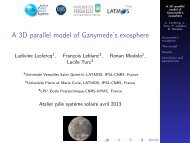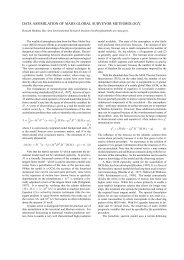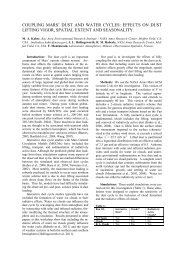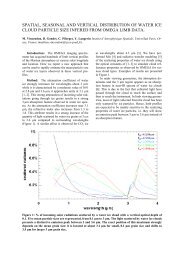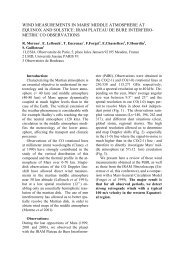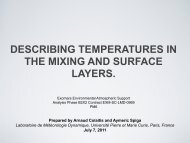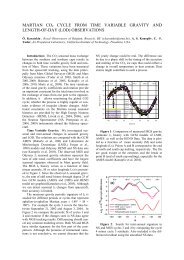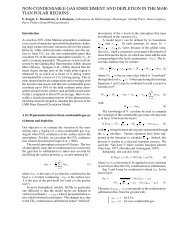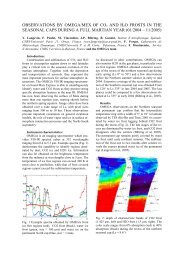MARS CLIMATE DATABASE v5.0 USER MANUAL - The Mars ...
MARS CLIMATE DATABASE v5.0 USER MANUAL - The Mars ...
MARS CLIMATE DATABASE v5.0 USER MANUAL - The Mars ...
Create successful ePaper yourself
Turn your PDF publications into a flip-book with our unique Google optimized e-Paper software.
Table 1: CALL MCD Input arguments (continued)xdatedoubleprecision(REAL*8)• if datekey=0: the Julian date.• if datekey=1: the solar longitude Ls (in degrees), Ls ∈[0 : 360]N.B. <strong>The</strong> subroutine julian.F can be used to compute the Julian date correspondingto a given calendar date (day, month, year, hours, minutes, seconds)on Earth.Note that this date essentially matters in order to compute the correspondingsolar longitude Ls of <strong>Mars</strong> (and that a different Earth date leading to same Lswill yield identical results).localtime real Local true solar time at longitude lon, in martian hours. Shouldonly be specified if datekey=1 and must be set to zero ifdatekey=0.dsetcharacterstringdim(*)N.B. Local true solar time is such that the sun is highest in the sky at noon. Amartian hour is defined as 1/24 th of a sol (a martian day, which is 88775.245s long).Path to the directory where the datafiles are to be found.dset may be of any size. If dset is an empty string, then thepath to the datasets is set the default path MCD DATA/.N.B. the given path must end with a “/” (e.g.: /home/data/) on Linux and“\” on Windows.scena integer Dust and solar EUV input scenario :1 = Climatology Scenario, solar EUV average conditions2 = Climatology Scenario, solar EUV minimum conditions3 = Climatology Scenario, solar EUV maximum conditions4 = dust storm τ = 5, solar minimum conditions5 = dust storm τ = 5, solar averaged conditions6 = dust storm τ = 5, solar maximum conditions7 = warm scenario: dusty atmosphere, solar max8 = cold scenario: low dust conditions, solar min.N.B. <strong>The</strong> solar conditions describe variations in the Extreme UV input whichcontrol the heating of the atmosphere above ∼120 km, which typically varieson a 11 years cycle. <strong>The</strong> different dust scenarios differ by dust amount anddistribution used to create the data files (dust is highly variable on <strong>Mars</strong> fromyear to year).<strong>The</strong> “Climatology” dust scenario is designed be representative of a baselinetypical <strong>Mars</strong> year.<strong>The</strong> warm and cold scenario are provided to bracket the possible dust contentof the atmosphere, outside global dust storms.dust storm τ = 5 represents <strong>Mars</strong> during a global dust storm (dust opacityset to 5 and using a darker dust). Only available when such storms arelikely to happen, during northern fall and winter (Ls=180-360).Please check the Detailed Design Document for further information.12



